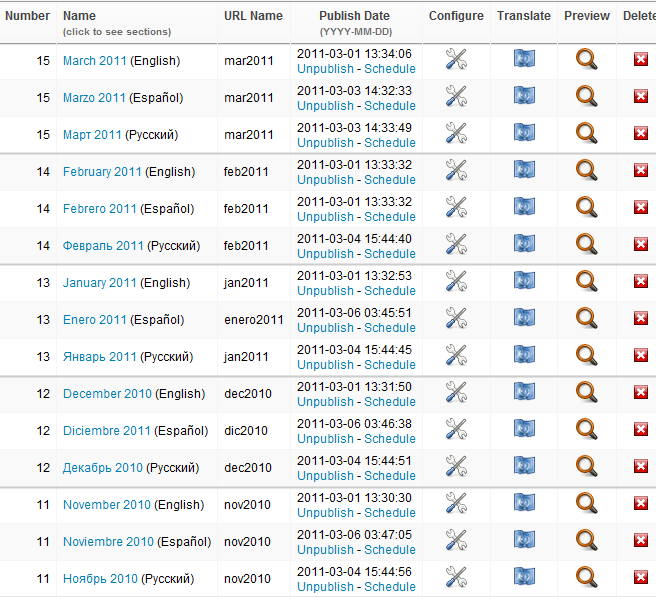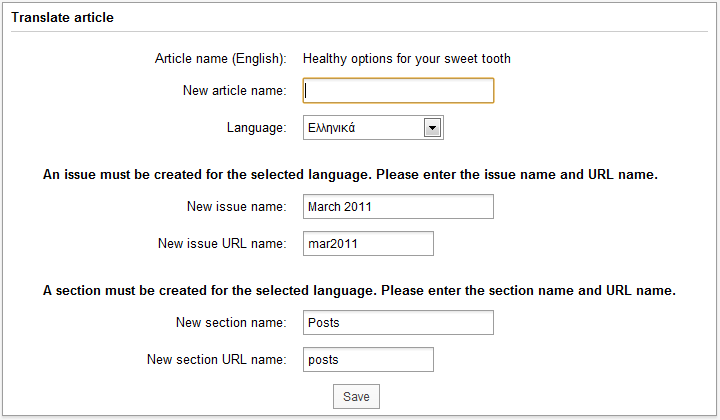Newscoop 4.1 Cookbook
Content in multiple languages
In this chapter, we're working with one of Newscoop's main advantages: the ability to easily create and manage multilingual publications. If you are running a multilingual site, this affects three parts of Newscoop:
- Journalists and editors can translate content in the backend. (This chapter is dealing with how this is displayed in templates).
- Strings in templates. The following chapter will show you how to translate content in the templates and display it for different languages.
- Language specific elements on the site. A following chapter will show you how to modify the structure of your template according to the language the content is in.
Multilingual content in the admin interface
The following screenshot shows the administration interface of a publication in English, Russian and Spanish. This is what you will see when you go to the list of issues:

List of issues in the admin interface for a multilingual publication in English, Russian and Spanish.
In Newscoop, there is the publication's default language (set in Content >Publication >Configure) and other language versions, or translations. Other languages are defined by creating translations of issues and articles. In the screenshot above, you can see that every issue is translated into two additional languages.
You don't need to create these translations with every new issue - when you add a new issue and choose the option to 'Use the structure of previous issue', a new issue will be created with all the language versions that already exist.
Note that all of an issue's language versions hold the same issue number. Similarly, sections in translated issues keep the original section's number, and translated articles keep the original article's number.
So how does Newscoop handle multilingual content? By changing the language parameter.
Take a look at these three URLs:
http://example.com/en/mar2011/posts/4/healthy-options.htm
http://example.com/es/mar2011/posts/4/opciones-saludables.htm
http://example.com/ru/mar2011/posts/4/-.htm
The most important difference regarding multilinguality lies in the language code (en, es, ru) and in the last part of the URL, generated using topics for SEO purposes. Incidentally, those links will work without that last part of the url. The article number (4) is enough to tell Newscoop which article it is.
Switching between languages
To switch from one language to another, we build a list of available languages. In our language switcher, if we change only the language parameter, all other parameters currently active will be used. If you change the language while on the article page, you will jump from translation to translation.
<ul>
{{ list_languages of_publication="true" }}
<li style="background: transparent url(http://{{ $gimme->publication->site }}/templates/_img/flags/{{ $gimme->language->code }}.png) no-repeat 5px center">
<a href="{{ url }}/">{{ $gimme->language->name }}</a>
</li>
{{ /list_languages }}
</ul>
This switcher lists all languages defined by the content inside a publication. Because you cannot place a Greek translation into a Spanish issue, the appropriate issue is automatically created at the moment when you try to create an article in a language which is not yet defined.

Now let's get back to our language switcher. It will try to keep the active issue, section and article (if they exist in the required language). If not, the switcher will simply fall back to the previous level where a translation exists (i.e. section, and if section doesn't exist, then issue, which definitely exists - otherwise it wouldn't be on the language list).
What happens once your user switches to another language? Newscoop tries to serve all database content in that language - not only articles, but all other elements like system values for date (day names and month names), topics, author biographies etc. It is therefore important that all these values are translated to languages you plan to use.
NOTE: There are some pieces of content that are not yet translatable:
- Image captions
- Form buttons
- Some configuration settings that might be used to output values, for example {{ $siteinfo.description }}
You can solve this situation with following workarounds:
- Create an article field of single-line text, where journalists can store translations of image captions
- For forms, you will need to set 'if' statements to check which language page is opened and to provide a version of the form with appropriate button labels (or graphical buttons)
- Skip using configuration values, and instead use the translatable information stored in the publication structure (in some special article maybe, or as section description, or... be creative)